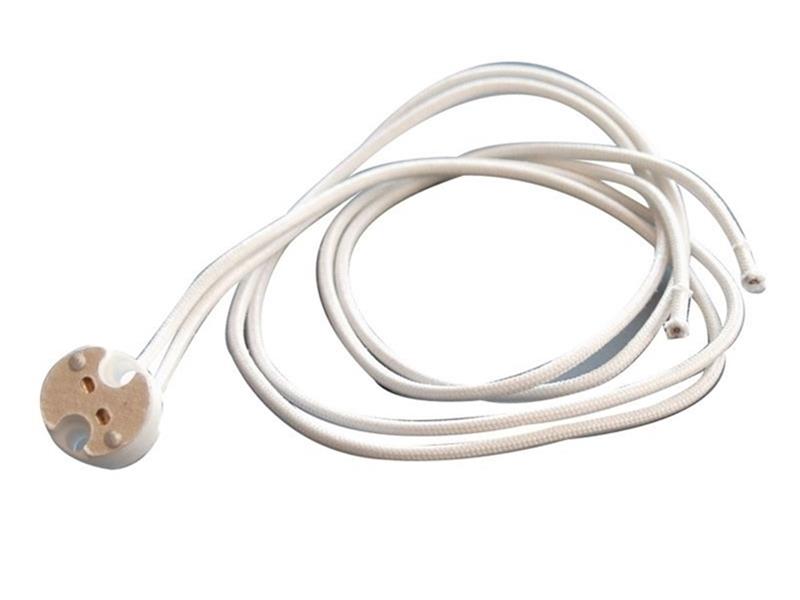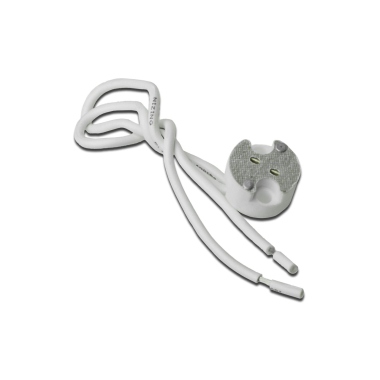Halogen Fassung

Bright and Compact
History (1953 - Today)
| Introduction & Statistics | Design Variations |
| Inventors and Developments |

Introduction:
The halogen lamp is also known as a quartz halogen and tungsten halogen lamp. It is an advanced form of incandescent lamp. The filament is composed of ductile tungsten and located in a gas filled bulb just like a standard tungsten bulb, however the gas in a halogen bulb is at a higher pressure (7-8 ATM). The glass bulb is made of fused quartz, high-silica glass or aluminosilicate. This bulb is stronger than standard glass in order to contain the high pressure. This lamp has been an industry standard for work lights and film/television lighting due to compact size and high lumen output. The halogen lamp is being replaced slowly by the white LED array lamp, miniature HID and fluorescent lamps. Increased efficiency halogens with 30+ lumens per watt may change sale decline in the future.
Those are the perks of using a halogen lamp. We offer energy-efficient replacement halogen bulbs in numerous styles, including floods, spots, capsule and tube-shaped bulbs for both home and business. Bulbs.com prides itself on carrying trusted brands and quality products. Bulbrite, Eiko, and Philips halogen bulbs can all be found in one place. 90-Watt PAR38 Halogen Indoor/Outdoor Flood Light Bulb (2-Pack) Philips EcoVantage 70-Watt long life PAR38 Philips EcoVantage 70-Watt long life PAR38 indoor/outdoor flood light bulb is ideal for use in living rooms, offices, kitchens, as well as your outdoor security fixtures. Philips EcoVantage bulbs are a bright, energy saving alternative to standard incandescent light bulbs.
All credits and sources are located at the bottom of each lighting page
Advantages/Disadvantages:

Advantages:
-Halogen Lamps are small, lightweight
-Low cost to produce
-Does not use mercury like CFLs(fluorescent) or mercury vapor lights
-Better color temperature than standard tungsten (2800-3400 Kelvin), it is closer to sunlight than the more 'orangy' standard tungsten.
-Longer life than a conventional incandescent
-Instant on to full brightness, no warm up time, and it is dimmable
Disadvantages:
-Extremely hot (easily capable of causing severe burns if the lamp is touched).
-The lamp is sensitive to oils left by the human skin, if you touch the bulb with your bare hands the oil left behind will heat up once the bulb is activated, this oil may cause an imbalance and result in a rupture of the bulb.
-Explosion, the bulb is capable of blowing and sending hot glass shards outward. A screen or layer of glass on the outside of the lamp can protect users.
-Not as efficient as HID lamps (Metal Halide and HPS lamps)
Halogen bulbs are a variation on incandescent bulb technology. There are definite advantages and disadvantages to halogen lighting, and factors to consider for the use of halogen bulbs in residential lighting.
One of the things that shorten an incandescent bulb’s life is that the tungsten within the bulb evaporates.
If a trace amount of a halogen gas (such methyl bromide) is added inside the bulb, a chemical reaction takes place which removes the tungsten from the wall of the glass and deposits it back onto the filament, extending the life of the bulb.
In order for that beneficial chemical reaction to take place, the filament needs to be hotter than for incandescent bulbs.
The good news is that a hotter filament produces a whiter light and is more efficient (more lumens per watt). The bad news is that a hotter filament means that the tungsten is evaporating faster, so a denser, more expensive fill gas (krypton) and a higher pressure are used to slow down the evaporation. A higher fill pressure will break a bulb made of soft glass, so a hard glass is used.
Costs rise when moving to a harder glass, so typically the glass envelope is made much smaller. A smaller glass envelope around a hotter filament results in a glass envelope that will get much hotter.
For a consumer considering a halogen bulb for indoor residential use, the high temperature of halogen bulbs deserves serious respect.
In this author’s opinion, the benefits do not outweigh the danger. I would consider a ceiling-hung halogen chandelier, but I will not use a freestanding halogen lamp inside of my home. If a freestanding halogen lamp fell over, or, if a freestanding lamp fixture is placed close to curtains or other flammables, a fire could result.
Don’t Touch!
When replacing any halogen bulb, do not touch the glass envelope. The salts in your skin oils penetrate and weaken the glass. The bulb not only has a shorter life, but when the bulb dies the filament doesn’t merely burn out, but rather the bulb envelope shatters. The light bulb industry calls it a “non-passive failure.”
Xenon-Halogen
Some newer halogen bulbs use expensive xenon instead of argon or krypton as the fill gas to improve the performance of the bulb. Some people call these new bulbs “xenon bulbs”, but other light bulb technologies also use xenon, so the name “xenon bulb” is confusing. “Xenon-halogen” would be a more precise term.
Halogen-IR(TM)
Halogen-IR(TM) is a halogen bulb with multiple thin layers of a special coating on the outside of the glass bulb. By carefully controlling the thickness of the layers, a selective filter results that is transparent to visible light but reflects infrared light. The infrared light that normally would escape as heat is reflected back onto the filament. Thus the filament is warmed by heat that would have escaped into the lamp’s surroundings, which makes the bulb more efficient.

Halogen Fassung G4
The most widespread use of the technology is in outdoor flood lamps. A 60 Watt H-IR(TM) can produce output similar to a 120 Watt standard incandescent or a 90 Watt standard halogen.
In Summary:
Halogen Fassung 12v
Advantages: Longer life, high light output, greater efficiency, compact size, whiter, brighter light with less blackening, dimmable
Disadvantages: More expensive than incandescent, higher heat output could result in risk of fire
Applications: Interior, interior recessed, track lighting, exterior floodlights and security lighting
———————————————————————————–
Thanks to our guest lighting expert – Lance Kaczorowski, who brings a wealth of expertise to the site:
Thanks to our guest lighting expert – Lance Kaczorowski,who brings a wealth of expertise to the site:
Kaczorowski, a native of New York City, now resides in Fort Wayne, IN. Kaczorowski has a 4-year degree in Mechanical Engineering from the University of Texas at Austin, and also a 2-year degree in Electronics Engineering Technology from the Community College of the Air Force. Kaczorowski’s broad work history includes (chronologically): Three years as a Mercedes-Benz mechanic; six years as an electronics technician with the Air Force; three years as a new product development engineer with General Electric Lighting in Cleveland; seven years as a new product development engineer and an engineering analyst with Grote Industries in Madison, IN; and currently as an engineering analyst with International Truck and Engine Corporation in Fort Wayne.
The first two years of Kaczorowski’s employment with General Electric consisted of extensive training in light source sciences and engineering under GE’s Edison Engineering Program. Kaczorowski’s experience with lighting was broadened at Grote Industries, which is a supplier of vehicle lighting for heavy duty trucks.
No related posts.